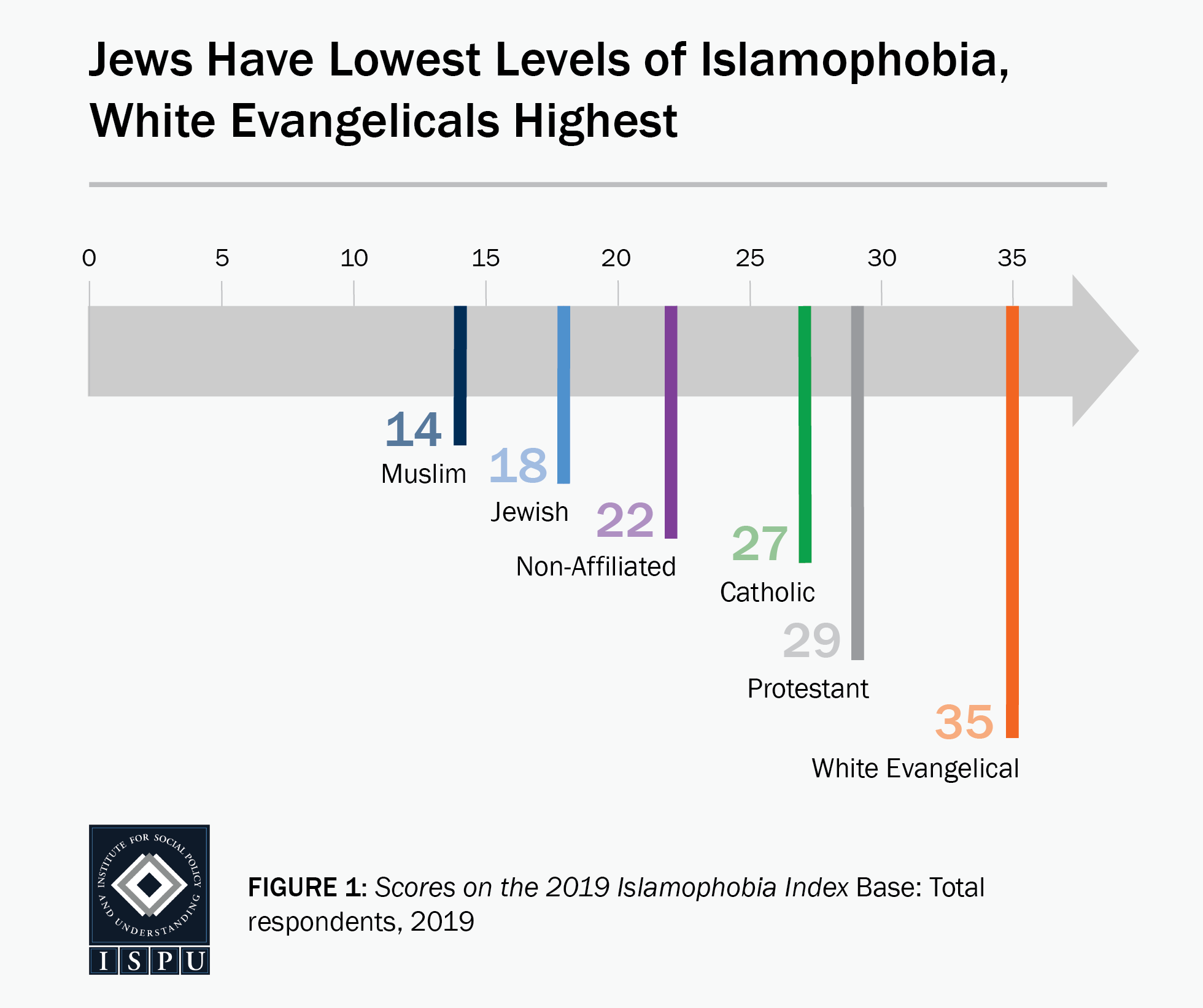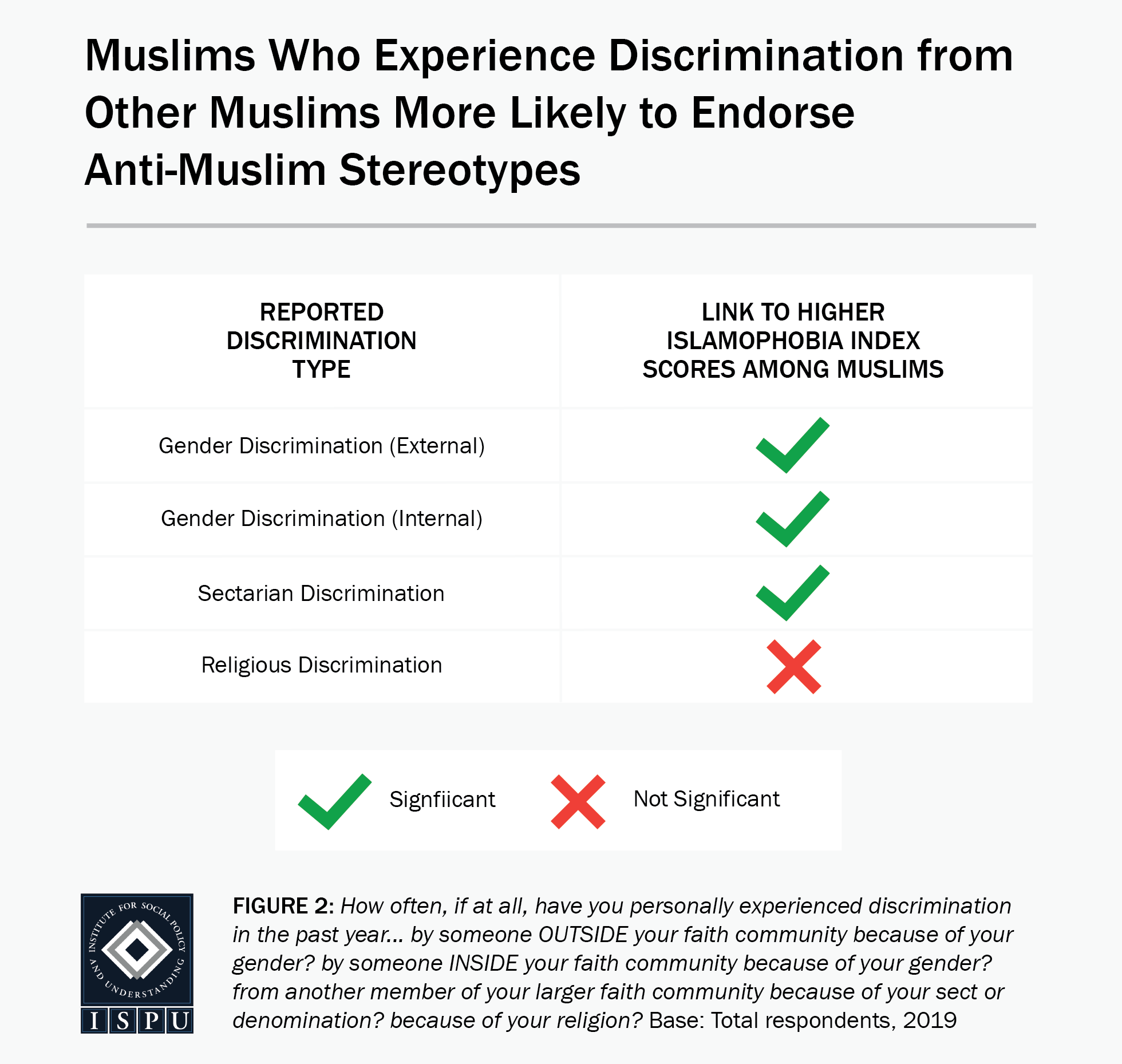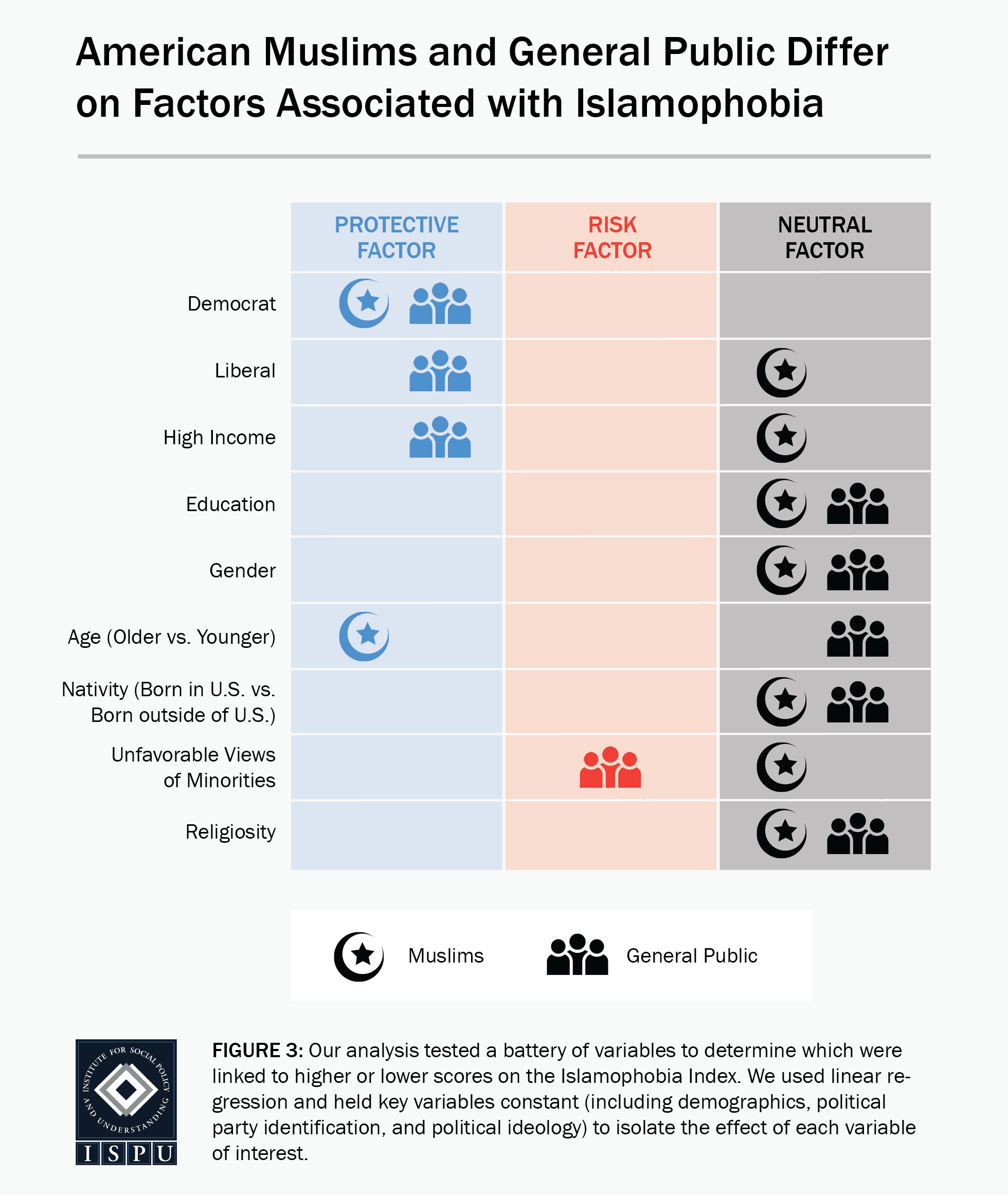DOWNLOADS
MORE ANALYSES
Unwanted Sexual Advances from Faith Leaders Are Equally Prevalent Across Faith Groups
Muslims Profess More Private Religious Devotion, Less Public Religious Assertiveness
The Majority of Muslims Believe Poverty Is the Result of Bad Circumstances, Not Bad Character
To Have and to Hold, Part Two: Interracial Marriage among American Muslims

Not Immune: Some Muslims in America Internalize Islamophobia
OCTOBER 7, 2019 | BY ERUM IKRAMULLAH
Over the last two years, the Institute for Social Policy and Understanding (ISPU) and Georgetown University’s Bridge Initiative have tracked anti-Muslim animus in the United States using a tool called the Islamophobia Index. [1] The index is a measure of the level of public endorsement of five negative stereotypes associated with Muslims in America. Agreement with these anti-Muslim tropes is associated with policies that restrict American Muslim rights. [2] These are the items used to construct the index:
Please indicate how much you agree or disagree with the following statements, where 1 means you strongly disagree and 5 means you strongly agree in regards to most Muslims living in the United States.
- Most Muslims living in the United States are more prone to violence than other people.
- Most Muslims living in the United States discriminate against women.
- Most Muslims living in the United States are hostile to the United States.
- Most Muslims living in the United States are less civilized than other people.
- Most Muslims living in the United States are partially responsible for acts of violence carried out by other Muslims.
A higher score on the index reflects greater belief that these negative stereotypes are true (despite evidence to the contrary), and thus indicate higher levels of Islamophobia held by the individual responding.
As expected, in 2019, Muslims scored the lowest of all faith groups surveyed on the Islamophobia Index, receiving a score of 14 compared to other faith and non-faith groups’ scores of 18–35 on the 1–100 scale (Figure 1). In 2018, Muslims scored 17 on the index, lower than all other groups surveyed except for non-affiliated Americans. However, while Muslims have the lowest levels of Islamophobia as a group, they are not immune to internalizing these stereotypes, as discussed at length in American Muslim Poll 2018: Pride and Prejudice.
In this secondary analysis, we seek to better understand this phenomena of internalized Islamophobia. We take a deeper look into individual risk and protective factors of internalized Islamophobia [3] using linear regression analysis. “Risk” and “protective” factors are a framework for categorizing determinants of an outcome. In this analysis, a “risk factor” is one that is correlated with a higher likelihood of experiencing internalized Islamophobia. Conversely, a “protective factor” is one that is correlated with a lower likelihood of experiencing internalized Islamophobia. We conducted these analyses among the sample of 804 Muslims surveyed in American Muslim Poll 2019: Predicting and Preventing Islamophobia.
Risk Factors: Experiencing Gender and Sectarian Discrimination from Other Muslims
One noteworthy finding is that Muslims who have personally experienced discrimination from other Muslims, either for their sect or gender, are more likely to have a higher score on the Islamophobia Index (Figure 2), meaning they are more prone to endorse anti-Muslim stereotypes. Negative real-life interactions with other Muslims are linked to a generalized endorsement of negative perceptions of the group, even among Muslims themselves. Experiencing gender discrimination from outside their faith community is also linked to higher scores on the Islamophobia Index for reasons that are not immediately apparent. It is interesting to note that experiencing religious discrimination in general has no predictive power at all, either in increasing or lowering Islamophobia Index scores.
Protective Factors: Demographics Play a Role
We found significant individual factors that protect against higher levels of internalized Islamophobia, mostly demographic characteristics. In particular, being a Democrat, being 30 years old or older, and self-identifying as Asian or Arab are protective against higher levels of Islamophobia among Muslims.
Nonsignificant Factors
Equally as interesting as examining significant factors that influence internalized Islamophobia is looking at what factors are not significantly correlated with Islamophobia among American Muslims. One set of factors that we hypothesized would be protective is religiosity, which we looked at in several different ways. To analyze this, we looked at more “public” measures, including the importance of religion in one’s life, frequency of religious service attendance, willingness to take unpopular stands to defend one’s faith, and impression of linked fate with faith group members. American Muslims who place higher importance on religion in their life, those who attend weekly religious services, were willing to take unpopular stands to defend Islam, and those who think that what happens to members of their faith community will affect them personally are not more or less likely to internalize Islamophobia. In other words, higher levels of public religiosity do not protect Muslims against endorsing anti-Muslim stereotypes.
We also examined factors of private devotion or religiosity. These factors include deriving meaning and purpose from one’s faith and being empowered by faith to forgive those who have hurt one deeply. None of these factors of private devotion were correlated with higher or lower levels of internalized Islamophobia.
Several demographic factors had no impact on Islamophobia among American Muslims. While experiencing gender discrimination (in general and from within the Muslim community) is linked to higher levels of internalized Islamophobia, a person’s gender is not significant. Muslim women and men are equally likely to internalize Islamophobia. Additionally, being born in the U.S. or elsewhere, income level, education level, and political ideology (liberalism vs. conservatism) do not impact American Muslims’ likelihood of internalized Islamophobia. Finally, in terms of race, we found that though identifying as Arab or Asian was linked to lower Islamophobia among Muslims, identifying as Black or white had no impact on one’s likelihood to internalize Islamophobia.
ISPU’s American Muslim Poll 2019 presents risk and protective factors of Islamophobia for the general population. While unfavorable views of minority groups [4] are correlated with higher levels of Islamophobia among the general public, they are not a significant predictor of internalized Islamophobia among Muslims (Figure 3). This suggests that while Islamophobia is part of a larger pattern of bigotry among the general public, it may not be for Muslims, and the root cause of internalized Islamophobia is different.
In summary, these analyses of 2019 data find that:
- Internalized Islamophobia is more a result of negative human interactions.
- Younger Muslims, those who are 18–29 years old, are at greater risk for internalizing Islamophobic tropes.
- Religiosity is not correlated with internalized Islamophobia. Higher levels of religiosity do not protect Muslims against internalizing stereotypes about their community.

Erum Ikramullah is the Research Project Manager at ISPU. Previously, she worked at Child Trends as a Research Analyst on both quantitative and qualitative research studies on topics related to reproductive health, risky adolescent behavior, and fatherhood. Learn more about Erum→
[1] Dalia Mogahed and Azka Mahmood, American Muslim Poll 2019: Predicting and Preventing Islamophobia (Institute for Social Policy and Understanding, 2019).
[2] See Nour Kteily and Emile Bruneau, “Backlash: The Politics and Real-World Consequences of Minority GroupDehumanization,” Personal and Social PsychologyBulletin 43, no. 1 (2017): 87–104 by the Society for Personality and Social Psychology, Inc.; Emile Bruneau, Nour Kteily, and Emily Falk, “Interventions Highlighting Hypocrisy Reduce Collective Blame of Muslims for Individual Acts of Violence and Assuage Anti-Muslim Hostility,” Personality and Social Psychology Bulletin 44, no. 3 (2018): 430–48; and Nour Kteily, Emile Bruneau, and Gordon Hodson, “They See Us as Less Than Human: Metadehumanization Predicts Intergroup Conflict via Reciprocal Dehumanization,” Journal ofPersonality and Social Psychology 110, no. 3 (2016): 343–70.
[3] For a discussion on the causes of internalized Islamophobia, see Dalia Mogahed and Youssef Chouhoud, American Muslim Poll 2018: Pride and Prejudice (Institute for Social Policy and Understanding, 2018).
[4] Minority groups include Black Americans, Muslims, Jews, feminists, and LGBTQ people.




